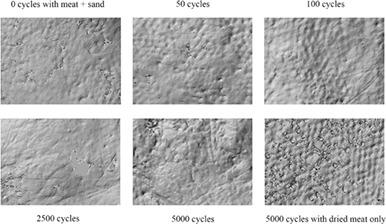当前位置:
X-MOL 学术
›
Am. J. Phys. Anthropol.
›
论文详情
Our official English website, www.x-mol.net, welcomes your feedback! (Note: you will need to create a separate account there.)
Technical note: Artificial Resynthesis Technology for the experimental formation of dental microwear textures
American Journal of Physical Anthropology ( IF 2.8 ) Pub Date : 2021-08-18 , DOI: 10.1002/ajpa.24395 Kristin L Krueger 1 , Evan Chwa 2 , Alexandria S Peterson 3 , John C Willman 4 , Alex Fok 5 , Bonita van Heel 5 , Young Heo 5 , Michael Weston 5 , Ralph DeLong 5
American Journal of Physical Anthropology ( IF 2.8 ) Pub Date : 2021-08-18 , DOI: 10.1002/ajpa.24395 Kristin L Krueger 1 , Evan Chwa 2 , Alexandria S Peterson 3 , John C Willman 4 , Alex Fok 5 , Bonita van Heel 5 , Young Heo 5 , Michael Weston 5 , Ralph DeLong 5
Affiliation

|
Dental microwear formation on the posterior dentition is largely attributed to an organism's diet. However, some have suggested that dietary and environmental abrasives contribute more to the formation process than food, calling into question the applicability of dental microwear to the reconstruction of diet in the fossil record. Creating microwear under controlled conditions would benefit this debate, but requires accurately replicating the oral environment. This study tests the applicability of Artificial Resynthesis Technology (ART 5) to create microwear textures while mitigating the challenges of past research. ART 5 is a simulator that replicates the chewing cycle, responds to changes in food texture, and simulates the actions of the oral cavity. Surgically extracted, occluding pairs of third molars (n = 2 pairs) were used in two chewing experiments: one with dried beef and another with sand added to the dried beef. High-resolution molds were taken at 0, 50, 100, 2500, and 5000 simulated chewing cycles, which equates to approximately 1 week of chewing. Preliminary results show that ART 5 produces microwear textures. Meat alone may produce enamel prism rod exposure at 5000 cycles, although attrition cannot be ruled out. Meat with sand accelerates the wear formation process, with enamel prism rods quickly obliterated and “pit-and-scratch” microwear forming at approximately 2500 cycles. Future work with ART 5 will incorporate a more thorough experimental protocol with improved controls, pH of the simulated oral environment, and grit measurements; however, these results indicate the potential of ART 5 in untangling the complex variables of dental microwear formation.
中文翻译:

技术说明:用于实验性形成牙科微磨损纹理的人工再合成技术
后牙列上牙齿微磨损的形成很大程度上归因于生物体的饮食。然而,有些人认为饮食和环境磨料比食物对形成过程的贡献更大,这对牙齿微磨损在化石记录中重建饮食的适用性提出了质疑。在受控条件下制造微磨损将有益于这场辩论,但需要准确复制口腔环境。这项研究测试了人工再合成技术 (ART 5) 在创建微磨损纹理的同时减轻过去研究挑战的适用性。ART 5 是一个模拟器,可复制咀嚼周期,对食物质地的变化做出反应,并模拟口腔的动作。手术拔除、咬合的第三磨牙对 ( n = 2 对)用于两个咀嚼实验:一个是牛肉干,另一个是在牛肉干中加入沙子。高分辨率模具是在 0、50、100、2500 和 5000 次模拟咀嚼周期下拍摄的,这相当于大约 1 周的咀嚼。初步结果表明,ART 5 产生微磨损纹理。肉单独可能会在 5000 次循环时产生釉质棱镜棒暴露,但不能排除磨损。带有沙子的肉会加速磨损形成过程,在大约 2500 次循环时,搪瓷棱柱杆会迅速消失并形成“坑和划痕”微磨损。ART 5 的未来工作将包含更全面的实验方案,包括改进的控制、模拟口腔环境的 pH 值和砂砾测量;然而,
更新日期:2021-10-13
中文翻译:

技术说明:用于实验性形成牙科微磨损纹理的人工再合成技术
后牙列上牙齿微磨损的形成很大程度上归因于生物体的饮食。然而,有些人认为饮食和环境磨料比食物对形成过程的贡献更大,这对牙齿微磨损在化石记录中重建饮食的适用性提出了质疑。在受控条件下制造微磨损将有益于这场辩论,但需要准确复制口腔环境。这项研究测试了人工再合成技术 (ART 5) 在创建微磨损纹理的同时减轻过去研究挑战的适用性。ART 5 是一个模拟器,可复制咀嚼周期,对食物质地的变化做出反应,并模拟口腔的动作。手术拔除、咬合的第三磨牙对 ( n = 2 对)用于两个咀嚼实验:一个是牛肉干,另一个是在牛肉干中加入沙子。高分辨率模具是在 0、50、100、2500 和 5000 次模拟咀嚼周期下拍摄的,这相当于大约 1 周的咀嚼。初步结果表明,ART 5 产生微磨损纹理。肉单独可能会在 5000 次循环时产生釉质棱镜棒暴露,但不能排除磨损。带有沙子的肉会加速磨损形成过程,在大约 2500 次循环时,搪瓷棱柱杆会迅速消失并形成“坑和划痕”微磨损。ART 5 的未来工作将包含更全面的实验方案,包括改进的控制、模拟口腔环境的 pH 值和砂砾测量;然而,



























 京公网安备 11010802027423号
京公网安备 11010802027423号